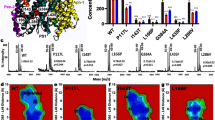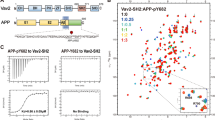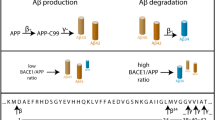Abstract
Mutations in the presenilin genes are associated with early onset familial Alzheimer's disease and lead to increased accumulation of βA4 peptide, the proteolytic product of the amyloid precursor protein (APP). To test whether presenilins interfere with APP metabolism, presenilin-2 (PS2) was coexpressed with APP in mammalian cells. Analysis of PS2 immunoprecipitates revealed that a fraction of APP was associated with the PS2 immunocomplexes. This non-covalent association was specific for the APP family of proteins and restricted to immature forms, occuring probably during transit through the endoplasmic reticulum. Additionally, coexpression with PS2 resulted in a decrease of APP secretion, suggesting a direct participation of presenilins in the intracellular sorting, trafficking and processing of APP molecules.
This is a preview of subscription content, access via your institution
Access options
Subscribe to this journal
Receive 12 print issues and online access
$209.00 per year
only $17.42 per issue
Buy this article
- Purchase on Springer Link
- Instant access to full article PDF
Prices may be subject to local taxes which are calculated during checkout
Similar content being viewed by others
References
Sherrington, R. et al. Cloning of a gene bearing missense mutations in early-onset familial Alzheimer's disease. Nature 375, 754–760 (1995).
Rogaev, E.I. et al. Familial Alzheimer's disease in kindreds with missense mutations in a gene on chromosome 1 related to the Alzheimer's disease type 3 gene. Nature 376, 775–778 (1995).
Levy-Lahad, E. et al. Candidate gene for the chromosome 1 familial Alzheimer's disease locus. Science 269, 973–977 (1995).
Van Broeckhoven, C. Presenilins and Alzheimer disease. Nature Genet. 11, 230–232 (1995).
Lemere, C.A. et al. The E280A presenilin 1 Alzheimer mutation produces increased Aβ42 deposition and severe cerebellar pathology. Nature Med. 2, 1146–1150 (1996).
Kang, J. et al. The precursor of Alzheimer's disease amyloid A4 protein resembles a cell-surface receptor. Nature 325, 733–736 (1987).
Selkoe, D.J., β-protein and the genetics of Alzheimer's disease. J. Biol. Chem. 271 18295–18298 (1996).
Weidemann, A. et al. Identification, biogenesis, and localization of precursors of Alzheimer's disease A4 amyloid protein. Cell 57, 115–126 (1989).
Esch, F.S. et al. Cleavage of amyloid β peptide during constitutive processing of its precursor. Science 248, 1122–1124 (1990).
Haass, C. et al. Amyloid beta-peptide is produced by cultured cells during normal metabolism. Nature 359, 322–325 (1992).
Shoji, M. et al. Production of the Alzheimer amyloid beta protein by normal proteolytic processing. Science 258, 126–129 (1992).
Suzuki, N. et al. An increased percentage of long amyloid β protein secreted by familial amyloid β protein precursor (βAPP717) mutants. Science 264, 1336–1340 (1994).
Jarrett, J.T., Berger, E.P. & Lansbury, P.T. Jr., The carboxy terminus of the beta amyloid protein is critical for the seeding of amyloid formation: Implications for the pathogenesis of Alzheimer's disease. Biochemistry 32, 4693–4697 (1993).
Citron, M. et al. Mutation of the β-amyloid precursor protein in familial Alzheimer's disease increases β-protein production. Nature 360, 672–674 (1992).
Cai, X.D., Golde, T.E. & Younkin, S.G. Release of excess amyloid β protein from a mutant amyloid β protein precursor. Science 259, 514–516 (1993).
Haass, C., Hung, A.Y., Selkoe, D. & Teplow, D.B. Mutations associated with a locus for familial Alzheimer's disease result in alternative processing of amyloid beta-protein precursor. J. Biol. Chem. 269, 17741–17748 (1994).
Kovacs, D.M. et al. Alzheimer-associated presenilins 1 and 2: Neuronal expression in brain and localization to intra cellular membranes in mammalian cells. Nature Med. 2, 224–229 (1996).
Scheuner, D. et al. Secreted amyloid β-protein similar to that in the senile plaque of Alzheimer's disease is increased in vivo by the presenilin 1 and 2 and APP mutations linked to familial Alzheimer's disease. Nature Med. 2, 864–870 (1996).
Duff, K. et al. Increased amyloid-b42 (43) in brains of mice expressing mutant presenilin 1. Nature 383, 710–713 (1996).
Thinakaran, G. et al. Endoproteoysis of presenilin 1 and acumulation of processed derivatives in vivo. Neuron 17, 1–20 (1996).
Mercken, M. et al. Characterisation of human presenilin 1 using N-terminal specific monoclonal antibodies: Evidence that Alzheimer mutations affect proteolytic processing. FEBS Lett. 389, 297–303 (1996).
Kim, T.W., Hallmark, O.G., Pettingell, W., Wasco, W. & Tanzi, R.E. Proteolytic processing of wild-type and mutant forms of presenilin 2. Neurobiol. Aging 17, 155–159 (1996).
Podlisny, M.B., Tolan, D.R. & Selkoe, D.J. Homology of the amyloid beta protein precursor in monkey and human supports a primate model for beta amyloidosis in Alzheimer's disease. Am. J. Pathol. 138, 1423–1435 (1991).
König, G. et al. Identification and differential expression of a novel alternative splice isoform of the βA4 amyloid precursor protein (APP) mRNA in leukocytes and brain microglial cells. J. Biol. Chem. 267, 10804–10809 (1992).
Wasco, W. et al. Identification of a mouse brain cDNA that encodes a protein related to the Alzheimer disease-associated amyloid beta protein precursor. Proc. Natl. Acad. Sci. USA 89, 10758–10762 (1992).
High, S. et al. Sec61p is adjacent to nascent type 1 and type II signal-anchor proteins during their membrane insertion. J. Cell Biol. 121, 743–750 (1993).
Simons, M.T. et al. Amyloidogenic processing of the human amyloid precursor protein in primary cultures of rat hippocampal neurons. J. Neurosci. 16, 899–908 (1996).
Hammond, C. & Helenius, A. Quality control in the secretory pathway: Retention of misfolded viral membrane glycoprotein involves cycling between the ER, intermediate compartment, and Golgi apparatus. J. Cell Biol. 126, 41 52 (1994).
Haass, C. & Selkoe, D.J. Cellular processing of beta-amyloid precursor protein and the genesis of amyloid beta-peptide. Cell 75, 1039–1042 (1993).
Kuentzel, S.L. et al. The Alzheimer β-amyloid protein precursor/protease nexin-II is cleaved by secretase in a trans-Golgi secretory compartment in human neuroglioma cells. Biochem. J. 295, 367–378 (1993).
Citron, M. et al. Inhibition of amyloid β-protein production in neural cells by the serine protease inhibitor AEBSF. Neuron 17, 171–179 (1996).
Zhong, Z., Quon, D., Higgins, L.S., Higaki, J. & Cordell, B. Increased amyloid production from aberrant beta-amyloid precursor proteins. J. Biol. Chem. 269, 12179–12184 (1994).
Games, D. et al. Alzheimer-type neuropathology in transgenic mice overexpressing V717F β–amyloid precursor protein. Nature 373, 523–527 (1995).
Knop, M., Finger, A., Braun, T., Hellmuth, K. & Wolf, D.H., Der1 a novel protein specifically required for endoplasmic reticulum degradation in yeast. EMBO J. 15, 753–763 (1996).
Kunkel, T.A., Roberts, J.D. & Zakour, R.A. Rapid and efficient site specific mutagenesis without phenotypic selection. Meth. Enzym. 154, 367–382 (1987).
Dyrks, T. et al. Generation of beta A4 from the amyloid protein precursor and fragments thereof. FEBS Lett. 335, 89–93 (1993).
Author information
Authors and Affiliations
Rights and permissions
About this article
Cite this article
Weidemann, A., Paliga, K., Dürrwang, U. et al. Formation of stable complexes between two Alzheimer's disease gene products: Presenilin-2 and β-amyloid precursor protein. Nat Med 3, 328–332 (1997). https://doi.org/10.1038/nm0397-328
Received:
Accepted:
Issue Date:
DOI: https://doi.org/10.1038/nm0397-328
This article is cited by
-
Differential effects of familial Alzheimer’s disease-causing mutations on amyloid precursor protein (APP) trafficking, proteolytic conversion, and synaptogenic activity
Acta Neuropathologica Communications (2023)
-
Presenilins and the intramembrane proteolysis of proteins: facts and fiction
Nature Cell Biology (2001)
-
Nicastrin binds to membrane-tethered Notch
Nature Cell Biology (2001)



